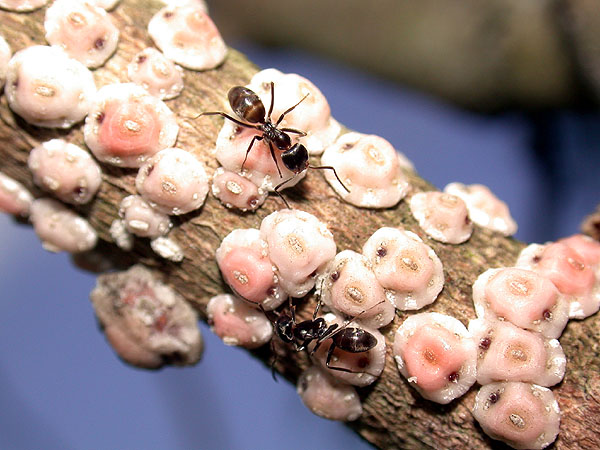

Designed by Paul Smith 2006. This website is copyrighted by law. Material contained herewith may not be used without the prior written permission of FAUNA Paraguay. Photographs on this web-site were taken by Paul Smith, Hemme Batjes, Regis Nossent,
Alberto Esquivel, Arne Lesterhuis, Rebbeca Zarza, José Luis Cartes and Hugo del Castillo and are used with their permission.
COCCIDAE: SCALE BUGS
Amongst the most bizarre of all insect groups, the females of Scale Bugs or Mealy Bugs as they are sometimes known, do not resemble insects at all - in fact it is difficult to tell even if they are alive! Adult females are grub-like and live below waxy structures or "scales", lack legs and are essentially immobile. The body produces the waxy secretion that forms the scale through specialised pores and setae, and scales may be soft, wooly or hardened depending on the species group. Males on the other hand resemble small flies, have three pairs of legs and well-developed antennae. Hindwings are greatly reduced. Males lack mouthparts and have a short life span - their role is purely reproductive, however some species completely do away with males and reproduce through parthenogenesis. In species that reproduce sexually males may possess extraordinarily elongated sexual organs that extend below the scale to fertilise the female. Life cycles are simple, typically eggs are laid below the scale and hatch into first instar nymphs or "crawlers". This mobile phase then departs using a variety of means to find new feeding sites. Once settled the legs and mobility may be lost, with those destined to become females passing through several instars before reaching adulthood. Males have only a few feeding stages and pass through one or two non-feeding pupa-like stages which is secreted by the second instar nymph.
Coccids are sap-feeders. The rostrum is short and possesses one or two segments, but the stylets are long and coiled within the head when not in use. They produce honeydew (sugar-rich secretions) which has resulted in a symbiotic relationship with certain ant species and other hymenopterans. Many species are specific to certain plant species, but others are more generalistic. Coccids are serious agricultural pests.
 | FIGURE 1 |
|
FIGURE 1 - Unidentified species being attended by ants, Departamento Ñeembucú (Alex Wild www.myrmecos.net).

